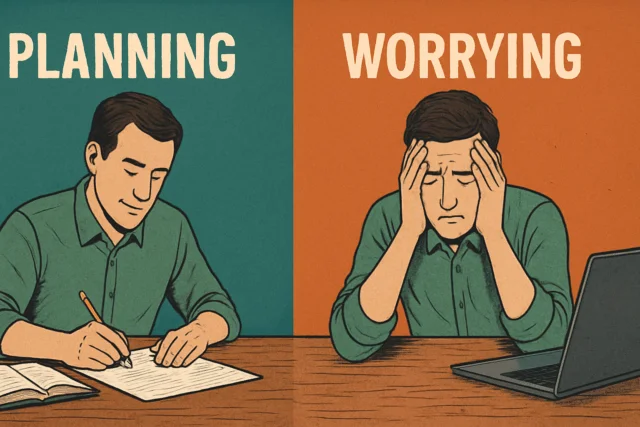 When we commit to a future action or outcome, we also implicitly or explicitly commit to the steps required to make it happen. This typically sets us down two paths: planning and worrying.
When we commit to a future action or outcome, we also implicitly or explicitly commit to the steps required to make it happen. This typically sets us down two paths: planning and worrying.
Planning involves strategy, sequencing, and intentionality. It lives in the thinking brain—the part that envisions steps, evaluates scenarios, and acts. Worrying, on the other hand, resides in our emotional centers. It’s a reaction, not a response: anxiety that we’ll forget something, mess something up, or fall short of success. As I explored in Unraveling the Confusion about Thinking and Feeling, confusing these two mental modes can muddle our judgment, especially when we mistake anxious feelings for useful thoughts. Noticing the difference helps us respond appropriately, not just react.
These two processes—planning and worrying—can feel similar, especially when we’re operating under pressure. But they’re fundamentally different in both mindset and effect.
What planning does
Planning puts us in motion. It focuses our attention on what we can do, not just what might happen. Planning creates structure and clarity, even if only provisional, and enables us to move from intention to implementation. It invites creativity: new ideas emerge as we map possibilities and prepare for uncertainties.
Good planning doesn’t ignore risk. It acknowledges that things won’t always go as expected, and it builds in options, flexibility, and fail-safes. As an event designer and facilitator, anticipating potential problems is simply part of the job. Contingency planning is not worrying. It’s thoughtful foresight.
What worrying does
Worry, by contrast, spins. It ties up our energy in emotional loops about imaginary futures. Worry shifts our attention from “What needs to happen next?” or “What might happen that we need to prepare for?” to “What if everything goes wrong?” While occasional worry can be a useful motivator—nudging us to act when we’re in denial or procrastinating—unchecked worry is rarely productive. It keeps us in our heads and out of the present moment, reacting to scenarios that may never materialize.
Worry can also masquerade as planning. But if you’re not making decisions, defining next steps, or clarifying outcomes, you’re probably not planning—you’re ruminating.
The tension between worrying and planning
Planning and worrying often occupy the same mental real estate. When we’re envisioning the future, it’s easy to slip from thoughtful preparation into anxious prediction. The key is to stay grounded in agency and action, holding the tension of uncertainty without letting it become fear.
For me, the trick is to treat each idea that arises, whether it’s an exciting opportunity or a potential disaster, as an invitation to design, rather than a reason to dread. What can I build now that will serve me later? What options can I open up that will make room for surprises—good or bad?
Of course, we know how unpredictable life can be. As the old saying goes, “Man plans and God laughs.” But that doesn’t mean we shouldn’t plan. It means we should plan with humility, clear-eyed about what we can control, and calm about what we can’t.
Suggestions
Planning lives in the thinking brain. It builds structure, invites creativity, and fosters agency. It may include thinking about what could go wrong, but it doesn’t live there.
Worrying lives in the emotional brain. It loops around uncertainty and pulls us away from effective action.
Being mindful of the distinction helps us stay focused, calm, and prepared, even in complex or high-stakes situations. Especially for those of us who create experiences for others, learning to plan without falling into worry is a skill worth practicing.
The best antidote to worry isn’t ignoring the future. It’s meeting it with thoughtful design, flexible intention, and a willingness to adapt. In other words: plan like a pro, and hold the results lightly.
